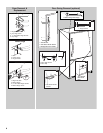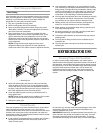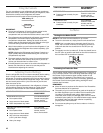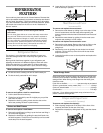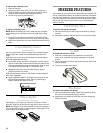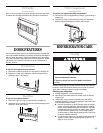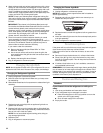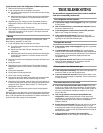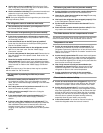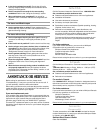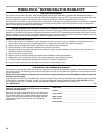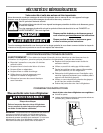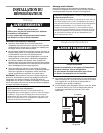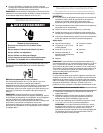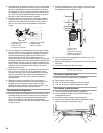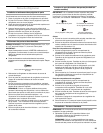
16
■ Are the doors closed completely? Push the doors firmly
shut. If they will not shut all the way, see “The doors will not
close completely” later in this section.
■
Are the condenser coils dirty? This prevents air transfer and
makes the motor work harder. Clean the condenser coils.
Refer to the “Cleaning” section.
NOTE: Your new refrigerator will run longer than your old one due
to its high-efficiency motor.
The refrigerator seems to make too much noise
■ The sounds may be normal for your refrigerator. Refer to
the “Normal Sounds” section.
The ice maker is not producing ice (on some models)
■ Is the freezer temperature cold enough to produce ice?
Wait 24 hours after hookup for ice production. See the “Using
the Control(s)” section.
■
Is the wire shutoff arm in the OFF (arm up) position?
Lower the wire shutoff arm to the ON (arm down) position.
See the “Ice Maker” section.
■
Is the water line shutoff valve to the refrigerator turned
on? Turn on the water valve. See the “Water Supply
Connection” section.
■ Is an ice cube jammed in the ejector arm? Remove the ice
from the ejector arm with a plastic utensil. Refer to the “Ice
Maker” section.
■ Does the ice maker mold have water in it or has no ice
been produced? Check to see if your refrigerator has been
connected to your home water supply and the supply shutoff
valve is turned on. Refer to the “Water Supply Connection”
section.
NOTE: If not due to any of the above, there may be a problem
with the water line. Call for service.
The ice maker is producing too little ice (on some
models)
■
Has the ice maker just been installed? Wait 72 hours for full
ice production to begin. Once your refrigerator is cooled
down, the ice maker should begin producing 70 to 120 cubes
every 24 hours.
■
Has a large amount of ice just been removed? Allow 24
hours for ice maker to produce more ice.
■
Is the control set correctly? Refer to the “Using the
Control(s)” section.
■
Is the water shutoff valve turned completely on? Turn
valve on fully. Refer to the “Water Supply Connection”
section.
■
Is there a water filter installed on the refrigerator? This
filter may be clogged or installed incorrectly. First, check the
filter installation instructions to ensure that the filter was
installed correctly and is not clogged. If installation or
clogging is not a problem, call a technician or other qualified
person.
Off-taste or gray color in the ice (on some models)
■ Are the plumbing connections new, causing discolored or
off-flavored ice? Discard the first few batches of ice.
■ Have the ice cubes been stored for too long? Throw away
old ice and make a new supply.
■
Has food in the refrigerator been wrapped properly? Refer
to the “Refrigerator Features” section.
■ Do the freezer and ice bin need to be cleaned? See the
“Cleaning” section.
■ Does the water contain minerals (such as sulfur)? A filter
may need to be installed to remove the minerals.
The divider between the two compartments is warm
The warmth is probably due to normal operation of the automatic
exterior moisture control. If still concerned, call for service.
Temperature is too warm
■
Are the air vents blocked in either compartment? This
prevents the movement of cold air from the freezer to the
refrigerator. Remove any objects from in front of the air vents.
Refer to the “Ensuring Proper Air Circulation” section for the
location of air vents.
■ Are the door(s) opened often? Be aware that the refrigerator
will warm when this occurs. In order to keep the refrigerator
cool, try to get everything you need out of the refrigerator at
once, keep food organized so it is easy to find, and close the
door as soon as the food is removed.
■
Has a large amount of food just been added to the
refrigerator or freezer? Adding a large amount of food
warms the refrigerator. It can take several hours for the
refrigerator to return to the normal temperature.
■
Are the controls set correctly for the surrounding
conditions? Refer to the “Using the Control(s)” section.
There is interior moisture buildup
■
Are the air vents blocked in the refrigerator? Remove any
objects from in front of the air vents. Refer to the “Ensuring
Proper Air Circulation” section for the location of air vents.
■
Are the door(s) opened often? To avoid humidity buildup,
try to get everything you need out of the refrigerator at once,
keep food organized so it is easy to find, and close the door
as soon as the food is removed. (When the door is opened,
humidity from the room air enters the refrigerator. The more
often the door is opened, the faster humidity builds up,
especially when the room itself is very humid.)
■
Is the room humid? It is normal for moisture to build up
inside the refrigerator when the room air is humid.



